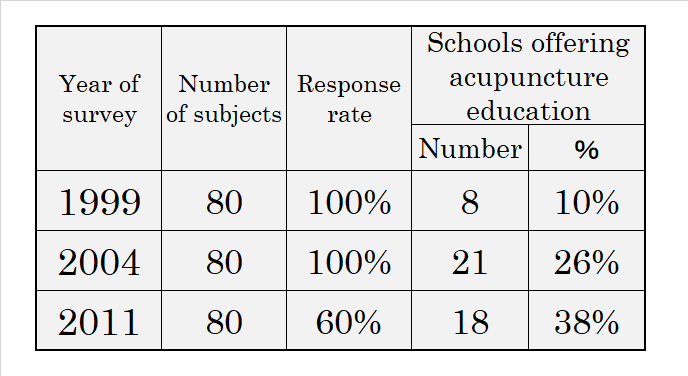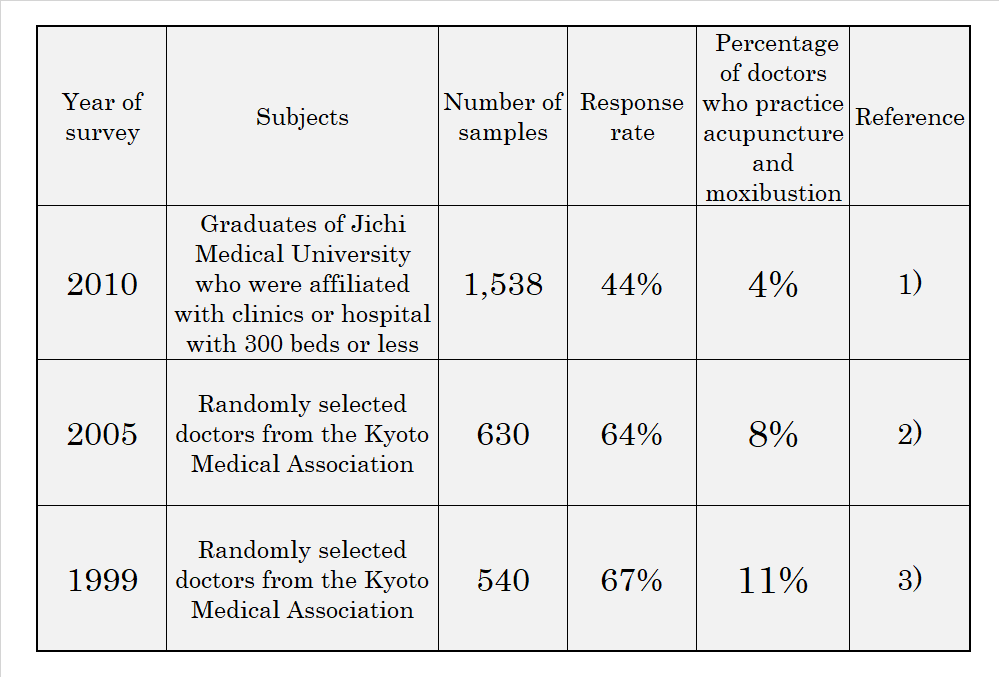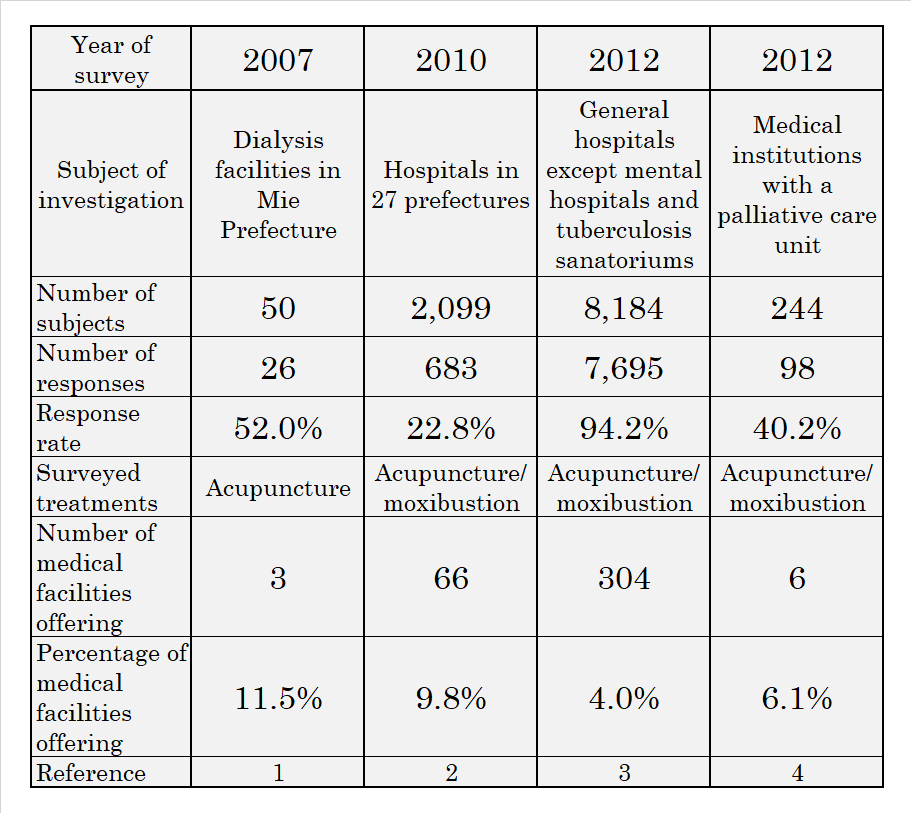Contents
4-1 Acupuncture education for medical students in Japan
4-2 Acupuncture in the postgraduate clinical training of doctors in Japan
4-3 Doctors who practice acupuncture and moxibustion in Japan: Percentage of doctors who do it
4-4 Medical facilities that offer acupuncture/moxibustion in Japan
4-1 Acupuncture education for medical students in Japan
4-1-1 Acupuncture in Japanese medical education
- The universities that train doctors in Japan offer medical education using the Model Core Curriculum for about two-thirds of the study hours in the six-year course. For the remaining one-third, each university voluntarily organizes educational content and conducts education. The Model Core Curriculum shows the qualities and abilities that must be acquired prior to graduation, but there is no mention of acupuncture.
Reference
1)The Model Core Curriculum for Medical Education (2016 revised edition), Ministry of Education, Culture, Sports, Science and Technology (in Japanese)
https://www.mext.go.jp/component/b_menu/shingi/toushin/__icsFiles/afieldfile/2017/06/28/1383961_01.pdf (9-27-2021)
4-1-2 Number of medical schools offering acupuncture education
Reference
1)Tsuruoka, Y. et al. Education in Complementary and Alternative Medicine in Japanese Medical Schools: Follow-Up Study, 1999-2004. Medical Education. 2005; 36(5):323-8 (in Japanese) https://www.jstage.jst.go.jp/article/mededjapan1970/36/5/36_5_323/_pdf (9-28-2021)
2)Katai, S. Acupuncture in Kampo’s education in the Medical Faculty. Social Acupuncture Research. 2011; 6:1-4 (in Japanese)
4-1-3 Number of medical schools offering moxibustion education
Reference
1)Katai, S. Acupuncture in Kampo’s education in the Medical Faculty. Social Acupuncture Research. 2011; 6:1-4 (in Japanese)
4-2 Acupuncture in the postgraduate clinical training of doctors in Japan
4-2-1 Medical clinic training under the Act
- Since 2004, medical doctors who engage in clinical practice have been required to undergo at least 2 years of medical training under the Medical Practitioners’ Act. The Ministry of Health, Labour and Welfare has set goals and strategies for clinical training, but there is no mention of acupuncture.
Reference
1) About the review of clinical training system for medical practitioners (March 30, 2018), Ministry of Health, Labour and Welfare (in Japanese)
https://www.mhlw.go.jp/file/05-Shingikai-10803000-Iseikyoku-Ijika/0000200863.pdf (10-04-2021)
4-2-2 Introduction of research reports on questionnaire surveys on acupuncture and moxibustion before and after clinical training
Methods
A follow-up survey was conducted to investigate the awareness of acupuncture and moxibustion among fourth-year medical students prior undergoing acupuncture and moxibustion education, as well as among residents who completed 2 years of postgraduate clinical training. The medical student surveys were conducted in 2008 and targeted 117 fourth-year medical students. On the other hand, the resident surveys were conducted from May 2013 to 2014. The resident surveys were conducted via postal questionnaire, targeting 93 individuals with possible contact information.
Results
- Among 93 residents, there were 72 (77.4%) effective responses.
- Only 3 residents (4%) had opportunities to learn acupuncture and/or moxibustion during residency. Among the 68 residents who did not have the opportunity to learn acupuncture and/or moxibustion during residency, 32 (47%) expressed interest in studying acupuncture and/or moxibustion.
- In a survey of medical students before the lecture, 55 (81%) respondents were interested in acupuncture and/or moxibustion, but after 2 years of clinical training, the number of respondents who were interested in acupuncture and/or moxibustion decreased to 32 (47%).
- In the survey of medical students, 23 (36%) respondents reported that they would positively introduce patients to a licensed acupuncturist, whereas this significantly decreased to 4 (6%) respondents the survey of residents. Furthermore, while no one stated that they would not recommend acupuncture and/or moxibustion in the survey of medical students, there were 10 (16%) post-residency respondents who would no longer consider endorsing it.
Conclusions
Postgraduate acupuncture and/or moxibustion education for medical residents appears to be relatively rare in Japan. In addition, medical residents had lower levels of interest in acupuncture and/or moxibustion compared to those demonstrated before their 4th-year acupuncture and moxibustion lectures in medical school.
Reference
Nakada Y, Takashi M, Arai K, Arai M. Medical residents’ interest in and current status of Japanese postgraduate education in acupuncture and moxibustion: a follow-up survey. Acupunct Med. 2017; 35(4): 297-302. https://www.ncbi.nlm.nih.gov/pmc/articles/PMC5561359/ (10-04-2021)
4-3 Doctors who practice acupuncture and moxibustion in Japan: Percentage of doctors who do it
Reference
1) Shin-ichi Muramatsu, Masakazu Aihara, Ihane Shimizu, Makoto Arai, Eiji Kajii, Current Status of Kampo Medicine in Community Health Care, General Medicine. 2012; 13 (1): 37-45
2) Kenji Fujiwara, Jiro Imanishi, Satoko Watanabe, Kotaro Ozasa, and Kumi Sakurada, Changes in Attitudes of Japanese Doctors toward Complementary and Alternative Medicine—Comparison of Surveys in 1999 and 2005 in Kyoto, Evidence-Based Complementary and Alternative Medicine, Volume 2011, Article ID 608921, doi:10.1093/ecam/nep040
3) Satoko Watanabe, Jiro Imanishi, Masako Satoh, Kotaro Ozasa, Unique Place of Kampo (Japanese Traditional Medicine) in Complementary and Alternative Medicine: A Survey of Doctors Belonging to the Regional Medical Association in Japan, The Tohoku Journal of Experimental Medicine, 2001; 194 (1): 55-63
4-4 Medical facilities that offer acupuncture/moxibustion in Japan
Reference
1)Sakuraba, H. et al. Questionnaire survey concerning acupuncture treatment to dialysis facilities in Mie Prefecture, Japan. Journal of the Japan Society of Acupuncture and Moxibustion. 2010; 60(2): 209-15 https://www.jstage.jst.go.jp/article/jjsam/60/2/60_2_209/_pdf/-char/ja (10-5-2021)
2)Yasuno, F. et al. Survey on the status of acupuncture and moxibustion in medical institutions (part1). Ido no Nippon. 2011; 818: 167-786 (in Japanese)
3) Yano, T. et al. Current status of acupuncture and moxibustion in general hospitals.
Ido no Nippon. 2012; 71(10): 174-86 (in Japanese)
4)Tomoaki Takanashi. et al. The survey of the practice of acupuncture and moxibustion therapy in medical institutions with a palliative care unit. Palliative Care Research. 2015; 10(1): 329-33 (in Japanese)




